#also side note that i liked: the wind temple theme uses parts of the attack on vah medoh theme
Explore tagged Tumblr posts
Text
great job link
#bwark#totk lb#i just beat it + did all the cutscenes after#really fucking good and a massive step up from botw#the boss actually requires some thinking rather than just attacking jt#i was gonna say that my only complaint is that tulin gets the great eagle bow but you know what? i'm okay with that#i like tulin and while he's still no revali for me i still think he deserves it#though that could be subject to change if there's anymore content with him#ACTUALLY my real complaint is that they don't acknowledge that it's revali's bow outside of the compendium#tulin's just like ''wow dad you're giving me this bow that means so much to you 🥺'' like SORRY i do not care about what the bow means#to teba. look's like my only revali crumbs from this game are gonna be revali's landing and the great eagle bow compendium 😔#also side note that i liked: the wind temple theme uses parts of the attack on vah medoh theme#also forgot to mention that the dungeon is still rather simple compared to past dungeons but i think i like these better??#idk how to describe it but yeah#overall 9.8 out of 10 dungeon experience and the negative is just me being a bitchy revali stan LMAO
19 notes
·
View notes
Text
Heretic/Hexen
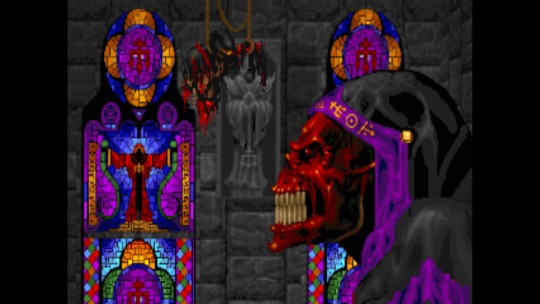
I love Doom. I’ve never made an attempt to list my favorite video games in a numerical order, but if I did, Doom would likely be one of the highest, if not #1. I’m also a big fan of the “dark fantasy” aesthetic, so discovering the Heretic/Hexen series was a treat, to say the least.
Released in 1994, Heretic was built using the Doom engine by Raven Software, with John Romero himself having helped the team set up their computers and teaching them the basics of how he would make maps for the game. With this in mind, you’d be forgiven for saying what a lot of reviewers said at the time: this game looks like a Doom reskin with a fantasy theme.

This sentiment mostly applies to the first game, Heretic. But in a sea of other “Doom clones” released at the time, it is definitely one of the more competent ones. You play as Corvus, one of the few surviving elves in a world overtaken by the evil Serpent Riders, who have decided to exterminate all the elves because their magical powers make them resistant to the mind control spells the Serpent Riders use to conquer and subjugate realm after realm on their quest for world domination. Unsurprisingly, Corvus is out for revenge, and the end goal of the game is to hunt down and kill the first of the three Serpent Riders, D’Sparil.
The gameplay in Heretic is more similar to Doom than in the later games, but it does the Doom formula well. Most weapons have a distinct counterpart in the game it is based on: the Elven Wand is your pistol, the Dragon Claw is your chaingun, the Ethereal Crossbow is your shotgun, and so on. They are satisfying to use (save the wand, arguably), and look deliciously fantasy-eque, with beautiful spritework. The levels are split into a familiar structure, featuring three episodes with nine levels each (and two more episodes released as an expansion pack). The enemies are varied, with pretty animations and distinct sounds, and play into the Doom experience very well in that the combinations and locations of enemies in each area lends itself to very different strategies (although “run really fast and blast everyone with the crossbow” rarely fails on most difficulties). The two expansion episodes are considerably more challenging, and will require more quick thinking and ammo, sorry, mana conservation. Definitely a fun romp.
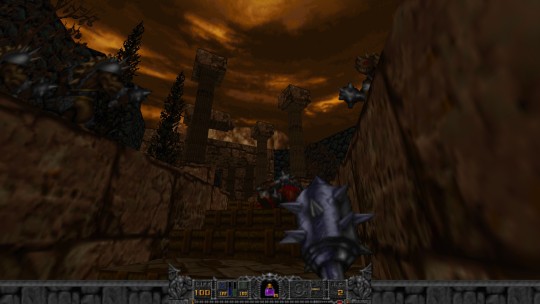
The sequel, Hexen, is where the series starts finding it’s own unique twist on the genre, and is the by many regarded as the “classic” that really put the franchise on the map. Again, you’re playing as a vindictive hero on a quest to liberate their realm from the Serpent Riders. This time it’s Korax, the second out of the three. However, now you’ve got to pick a class. This is the first big difference you’ll notice when starting the game. Corvus is MIA from his last adventure, and instead your choice of protagonist is between Baratus the Fighter, Parias the Cleric, and Daedolon the mage. While the game isn’t an RPG, these characters all have different stats when it comes to running speed and base HP. More importantly, they each have access to their own unique set of weapons. Mana is shared between the weapons, which are now split into green, blue and dual mana types, but they all behave very differently. For example, the fighter’s weapons are mostly of the melee variety and consume mana rapidly only for special attack modes, as they can still be swung without mana. The mage on the other hand uses his bare hands to cast a lot of his spells, but they do not burn through mana nearly as quickly. Unsurprisingly, the cleric is a hybrid, and uses both a spiked club and a mix of magical weapons. An “ultimate” weapon is also available to each class, which must be assembled from parts and consumes both blue and green mana, but has really devastating attacks (the cleric’s “Wraithverge” summons ghosts that scream like banshees and tear every nearby enemy to shreds; it’s just as metal as it sounds)!
Beyond the class differences, the level structure is the other major difference between Heretic and Hexen. Instead of a linear series of levels, each episode is now defined by a hub level with many branching areas that can usually be visited in any order. You need to find key items and activate switches in each one to open the way to the next world, and many areas within each sub-level are also locked until you find the right key/switch in a completely different area. As would be expected, this new spin on the level progression comes with both pros and cons. Few players today will be able to complete the game without ever looking at a walkthrough, and based on some comments I’ve read, this is one of those games that many people in the 90s would only dream of beating on their own. That said, there are very few instances where pulling a switch won’t at the very least give you a short message indicating it’s purpose (i.e. “A door has opened in the Wastelands”), and even then those with enough patience will rarely feel completely lost if they’re willing to backtrack systematically through every area over and over, taking note of every single locked door and unreachable area. I doubt it’s something the majority of gamers enjoy doing, but if you’re the type who would rather give up before accepting a hint, I’m happy to report that this game IS beatable even with your play style.
On the other hand, this structure also adds a lot to the feeling of being on a dangerous, epic quest. Metroidvania fans know that there are few things as satisfying as picking up a key and thinking “hey, I recognize this symbol! Now I can finally see what’s behind that door in the swamp!”. Uncovering the world bit by bit in this fashion really lends an air of mystery to the land of Cronos (where Hexen is set), and truly gives you that classic feeling of “pride and accomplishment” when you’re finally able to descend into that forbidding temple that’s been looming on the horizon for so long. And for those of you who are worried you won’t get to blast enough monsters to get your fill, this game still has you covered.
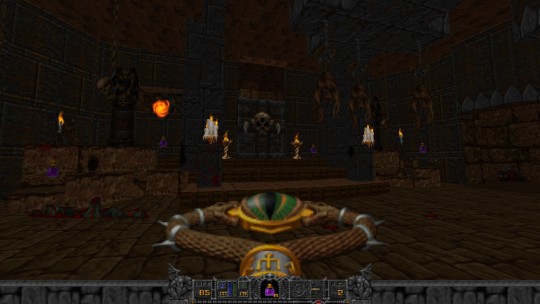
The enemies in Hexen are just as threatening as those in Heretic, and they look even better this time (seriously, if you enjoyed the visual aspect of Heretic, Hexen steps it up tenfold with truly gorgeous sprites, textures, animations and even some environmental visual effects, like thick mist and dead leaves blowing in the wind). You’ve got a fantastic cast of evil wizards, zombies, dog-like orcs, Minotaurs and more types of dragons and dragon hybrids than you could shake a Mace of Contrition at. A good amount of the baddies are initially very similar to those in Heretic, but their attacks are more distinct, varied and dangerous, and there are a whole lot more of these guys this time around. If you have the enemy counter turned on in your automap it won’t be uncommon to see the numbers exceed 400, and some of the weaker enemies will even respawn after a while. Don’t worry though, it’s not frequent enough to be stressful, but instead it really helps the backtracking from getting too tedious. Key hunting is a lot more intense when you never know if an Ettin is waiting around the corner to cave your skull in! However, if you’ve seen any other reviews of this game, you’ve heard a lot of grief expressed in regards to the Minotaurs (and their big brothers, the Maulotaurs). They aren’t the strongest foe in the game, but their shields, their surprise lighting bolts and their sheer numbers can definitely be a pain in the gluteus maximus. On the plus side, it makes killing them all the more satisfying, and you’ll find yourself experimenting quite a bit with your weapons and items to figure out the safest and quickest way to end their existence.
That’s right, I forgot to mention the items. The third and last major difference between Doom and these games is your inventory. The items are largely the same in all the games in the series, and using them can be a bit of a hassle unless you’re willing to fiddle around with your control settings to find a setup you prefer (I would usually bind the item selection keys to the scroll wheel and use them with the right mouse button). Visually, the inventory is similar to that seen in Duke Nukem 3D, and just like in that game, you’ll likely find yourself using some items a lot more frequently than others. Health and mana refills are a major aid, and beyond that you have things such as invisibility, invincibility, flechettes (despite what the name says, they’re more like grenades or mines, depending on your class), and a magical book that gives your weapons a much more powerful firing mode for a short time (although this item is mysteriously absent in Hexen). A special mention also goes to the Morph Ovum/Porkelator/Seal of the Ovinomancer, which transforms an enemy into a chicken/pig/sheep, respectively. A lot of fun to use, and and immense help against some stronger enemies if you’re low on health and/or mana.

If you didn’t find yourself using these items all too much in Heretic or Hexen, the following game might just give you a reason to. Hexen II is the third game in the series, and the final chapter in the Serpent Riders saga. This time you’re in the realm of Thyrion, and the last Serpent Rider, Eidolon, is the one who must be slain to free the land from his curse. In terms of gameplay, Hexen II is a lot more similar to Hexen than Hexen was to Heretic. You’ve got the same type of hub level structure, and you’ll again pick a class at the start, although now your choice has expanded, consisting of the Crusader, Paladin, Necromancer and Assassin, as well as the Demoness in the expansion (yes, all these games have expansion packs and they’re all worth playing in that they’re more of the same, but expanded, duh, and more polished).
The major difference this time around is one you can probably tell immediately from the screenshot: yes, Hexen II goes 3D (and in an exception to the common rule at the time, it is NOT titled “Hexen 3D” despite technically being the third installment). Specifically, the game uses a modified Quake engine. As mentioned, the core gameplay remains largely the same as in Hexen, but the level designers definitely did not waste that extra dimension. The levels are less expansive here, but a lot more complex and full of hidden passages, surprising loops and a whole lot of verticality. Scurring across a courtyard with archers raining arrows down on you from balconies is just as tense as it is satisfying later on to reach the same balcony and return the favor to any ghoul unlucky enough to find themselves below. Overall, the layout and progression in each area feels like it’s been given a lot more consideration and has endured more testing. Most of the time, the key hunting in each area feels more self-contained, and when it isn’t you rarely feel like you have no idea where to go. This is because every lock has been designed to feel more like a puzzle. In practice, your goal is still to find an item and bring it somewhere, but the locks and keys themselves are much more distinct, which helps you remember what to do and where to go. Instead of levers and typical keys, you find yourself looking for artefacts such as potion ingredients that will let you turn metal into wood, pieces of a broken mechanism or symbolic relics that must be placed in the hands of a statue to go in line with a prophecy. There are also more direct instructions in the form of book entries and inscribed stone tablets, which are very helpful in those cases where the puzzle might require a bit more than just item hunting, such as pulling switches in a certain order or lining objects up to create a pattern. It’s still unlikely that you’ll breeze through the whole game without getting confused, but you’ll rarely be at a complete loss; you’ll usually know what you’re looking for or what you’re trying to activate, even if you may need a walkthrough to find a specific hidden passage or to figure out exactly what a contraption does.
Overall, Hexen II feels like a refined Hexen, with more care put into making every area feel very distinct. It is absolutely not any less challenging though. The areas might be smaller in terms of actual units of measurement, and there are definitely fewer enemies on the screen at all times, but this is compensated for in spades. The third dimension adds a thick layer of complexity to every level, and the enemies hit HARD. If you got into a rhythm in Hexen of circle strafing, dodging and picking off targets in an order of perceived priority, you’ll have to learn to dance to a different tune here. Some enemies will close in on you incredibly quickly, and many of them have the ability to turn you into minced meat in a matter of seconds. Now more than ever is when you’ll want to shoot with a steady aim, use your items wisely, keep all the possible paths of retreat in your mental map, and scour every nook and cranny for health and mana to stand a chance against some of the stronger mooks. Hexen II as a whole is a lot more fast paced and tense and also has a more dramatic views and set pieces along with some extra bits of storytelling scattered around the world for those interested.

So, what are my thoughts on the Heretic/Hexen series as a whole? In short, it’s a treat. Combining classic fantasy tropes with the hectic action of Doom (and Quake) was an idea that was bound to happen sooner or later, and in this case, it worked out really well. There are of course other examples of this iconic clash of genres (check out Amid Evil for a totally kick-ass recent example!), but from what I know, the Serpent Riders saga is the one with the most lasting appeal. All the games strike a great balance between frantic, gory FPS action and the slower paced mystery and brooding sense of evil that only dark castles and dungeons can provide, with each game leaning a bit more toward one direction or the other. At a core gameplay level, there is nothing absolutely groundbreaking about Heretic/Hexen, but every element is done well and with care, and the presentation oozes of 20th century gothic fantasy charm, both the visuals and music. If the first paragraph of this review made you go “oh, those are both things I like!” then definitely check these games out. Same goes for anyone who is simply curious about the history of Id software and the impact Doom and Quake had on the gaming landscape. My only warning to you before playing these games is this: keep in mind that these games are from the 90s. There’s a reason many people have memories of booting these games up, getting completely stuck and then never playing them again. That said, as long as you have an internet connection (how else would you be reading this?) and an average amount of patience, there’s a whole lot of fun to be had here. All the games mentioned above are available on Steam (and GoG as well, I believe), and play excellently with modern source ports: gzdoom for Heretic and Hexen, and Hammer of Thyrion for Hexen II are my recommendations.
Finally, there is another game in the franchise. Heretic II returns to the story of Corvus (from the first game) and continues the story beyond the Serpent Riders arc, but due to some licensing issues it is not available on neither Steam nor GoG. Technically you could still buy a physical copy of the game, and I’ve seen mentions of at least one fan endeavor to make the game more accessible on modern computers, but I have yet to check it out. Maybe in the future. For now, I hope you enjoyed this dive into one of the slightly less famous, but still very popular classic 90s “Doom clones”!
34 notes
·
View notes
Text
Where do dragons and avis stand?
...among all of these primeval faiths none seemed to provide protection to our kind. Some turned their gazes to the skies, and started worshiping the winged ones, trying to appease their fury and displace their hunger to something else. When the dragons managed to drive their natural enemies, the avis, out of the scene, they became the supreme overlords of the skies, without challenge, without doubt.
With time, grand temples were built to honor the dragons and appease them as rulers of this world. Many of these places survive today as ancient ruins, silent witness to thousands of years of bloodshed and slavery of our kind, while others were completely decimated.
Dragons naturally, embraced their role as god-kings over humanity. After all, were they not fashioned in the gods’ own image? Superior in every way to the hordes of small, soft creatures that worshiped them. Erebus shaped them out of creation itself; they were the first born, the dearest children, it was only natural. And now there were no longer the challenging avis to try and fight them... but could their destined opponents come back to the scene, after thousands of years?
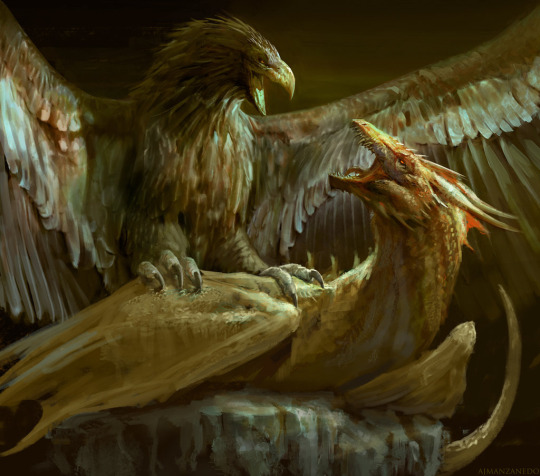
I have been thinking a lot these days, concerning dragons and the influence they play on my imagination and stories... looking upon it, its easy to get a feeling that they are very important to me, so I just wanted to dabble a bit on the psychological aspects of these beasts and their own nature, on the ‘why’ I find them interesting and worth of including in my story.
Of course, I find them aesthetically awesome and very interesting creatures to work with, but what about their minds? What just goes through a dragon’s mind? This is a question that had ‘plagued’ me for a long long time and that I’ll try to explain my view here. Take note that this is not the only way to make a ‘dragon creature’, but my own view, of what those beasts are made of and what made me fall in love with them as characters:
"What is better – to be born good, or to overcome your evil nature through great effort?"―Paarthurnax
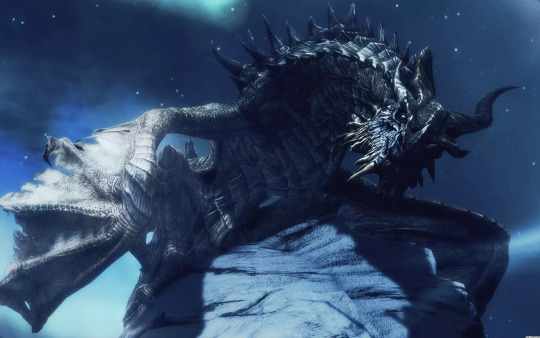
Its true, I have loved dragons since childhood, but the topic was never taken much serious before I read the Inheritance cycle by Paolini which features very interesting dragons... but this wasn't enough.
Perhaps, the final things that turned my attention back to them and made me interested in working with them on a psychological level was this quote from Paarthurnax, an elder dragon from Skyrim. He could be called a ‘good natured character’ for his role in the game, but as the quote illustrate, one who wasn't born ‘good’ but worked a lot to change his own nature.
For some reason this quote captured me back in 2011 as I first went through the game, it resonates deeply with how I view certain things and themes for my characters. Its no secret that I do take Skyrim as a huge inspiration for my stuff.
Now back to my dragons, and what I want them to be:
First and foremost, dragons are ‘mythological’ creatures in my verse, they are the stuff of legends... and they are extremely cunning and intelligent, while at the same time they are still definitely beastly... so it involves two of my favorite themes to work with:
1: Mythology is real and right in front of you! you live in mythological times... how does one deal with that? How does one deal with a huge overpowering beast such as a dragon?
Is it possible to peer into their minds and relate to them? Or are them so indifferent that it is not possible to even draw their attention? Humans might be mere livestock for them... and yet, and still, covenants between dragon and man have been made, so this might not be entirely true, at least for some of them.
2: God is not human. “God” is a pair of winged deities. Dragons are god-sent creatures and as much as its easy to humanize them for being able of ‘human speech’, they’re not human... they’re something else. One thing that really bothers me when reading fantasy novels is when a ‘dragon’ or ‘monster’ character takes human form and completely loses its beastly attributes. And I’m not talking about physical bodies, but the mindset. Or even when they keep their beastly forms, their minds are exactly what you would, expect of a regular person.
I want to see the animal instincts seeping in, the power of such creature and how it affects its mindset and values. Few novels have managed to do it properly, in my opinion of what I expect of a dragon... they are either pure animals or pure humans.... they are either seemingly unaware of their size and teeth and claws, etc.. I don’t mean they are ‘wrong or bad dragons’, just not how I envision them and wish to work with them.
The thing that intrigues me is what should the mind of a creature such as a dragon look like? How would their sheer size, immortality and power affect their thinking? Unfortunately we have never had contact a non-human species capable of comparable intellect, speech patterns and understanding (even thought I do value immensely the intellect of non-human animals such as dolphins, parrots, corvids, monkeys, etc.. and take them as examples of how non-humans could communicate and behave). I do imagine what would happen when we could truly communicate with a different creature of such magnitude.
If I manage to work properly my dragons the way I envision them, they should feel inherently inhuman, and at the same time, like the gods of ancient times themselves, they should be able to eventually take an interest in what goes behind a mortal’s mind and meddle in day to day life in their own way... they have their own set of values that sets them apart from humans, but they can try to understand us if they wish to, just as we can try and look past the species barrier and... they are capable of love..
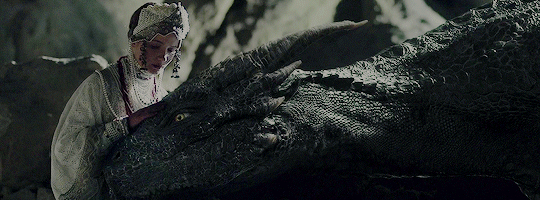
..and hatred, just like us...
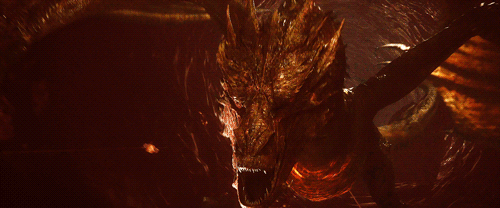
I like to take the ancient polytheistic gods of different cultures as examples for this case, as weird as it looks... they are inhuman creatures and sometimes can take an interest in ourselves, to the point of extremes, sometimes... why did the gods, in all their power and glory, care historically for us, taught humans many important things that enabled the development of civilization and even loved humans, physically and metaphorically, in various stories? ...
One nice example is...
Prometheus who defies the gods by stealing fire and giving it to humanity, an act that enabled progress and civilization. Prometheus is known for his intelligence and as a champion of mankind.
So, it is possible for said creatures not only take an interest in mankind, but even take their side and challenge their own brethren, being grievously punished in the end...it is possible, for a dragon, and everlasting beast to feel these things? Can the softness and ephemeral nature of the humans permeate their armored bodies? Can a dragon ‘sacrifice themselves’ for a human?
Going back to dragons and avis:
Its important to remember, that in-lore, unlike humans whom are considered a ‘mongrel’ race and have evolve for its own end, dragons and avis are creatures with a purpose that reflects their own sire deity:

Dragons are ‘conservation’, stasis, order. Dragons are prideful and they are most happy when meditating, alone and quiet in their safe havens.. dreaming a dream with no end. However, their creation and nature prevents them from achieving that: dragons have a strong, indomitable will to dominate, their nature is ‘attached’ to the world, they were meant to keep order. The dominating nature of dragons, perhaps steers from their immeasurable hunger, as since being struck down by the gods and bind to Aidera, they struggle with a huge need of eating to maintain their immense bodies... however, unlike the avians, they do not have a hunting drive and prefer to use humans as a mean of attaining food from them and receiving livestock sacrifices as nourishment.
Dragons were struck down from the astral planes were they dwelt, and became living creatures, even thought their bodies and aether qualities work in different ways. The elder dragons that have fallen back then have each been given an aspect or ‘element’ to reign upon and keep order...
They also feel the need to dominate, in order to have peace of soul and mind, they dislike conflicts, for the most part, and only would use force and violence when provoked (or not properly taken care of)...

Avis are ‘destruction’, disorder, chaos. Avis are most happy when flying on the high winds, they care little for the problems of mankind and they don’t depend on them. They are the definition of a ‘free spirit’.
Avis have a strong hunting drive. Avis are a different case and perhaps their mindset is even more difficult to peer into.. they are extremely detached creatures, they do not ‘care’ for the world bellow... they have an inherent "inability to connect" and they simply soar higher and higher, and if it wasn't from their physical needs they might as well fly to end of days.
However, eventually they needed to focus as the dragons began purging them out of their lands on Aralath. Avis were given the ‘phoenix’ power as a mean to counter attack the dragons, but as proven by history, this caused their undoing.
The red phoenix is the symbol of destruction and harbinger of chaos, as it represents the ultimate will of the avis to transcend and ‘burn’, to ascend to higher and higher and it symbolizes their vengeance too, it proves that even the detached avis can take things personally, and its and example of the overcoming of nature once again.
However, the red phoenix is a very egoistical thing in nature. Its the honed avis essence to the extreme, and not necessarily a good or bad thing, but certainly an aspect of nature that things must be destroyed in order for new things to be able to sprout and new life be created... in this regard, obviously the blue and purple phoenix are achievements of the lineage of avians who managed to dilute a bit and control this essence of destruction, achieving new heights... who knows how far can the avians go, with the allied essence of the avis with the humans?
Still, the red phoenix is the integral part that must be dealt with by Aquila in the story and again the theme of ‘overcome one’s own nature’ is worked here, hopefully to an interesting ending...
However here is the overcoming of the nature. Can an avis control their blood-lust and prey drive? Can a dragon control their pride and insatiable hunger? Its clear, looking at avian society, especially Aerynith from the floating isles, that they have a strong escapist tendency, they easily overlook and ignore the struggles going bellow their homes, they delight in their own safe havens and their hunting skills. Even the tribes have escapist tendencies, dwelling in their never ending dreams. The draconian society, or what is left of it has a certain imperialist mindset... draconians tend to be self centered and righteous people.. they feel like the world should belong to them...
The avis are all gone, and their time past.. the dragons are but a shadow of their former selves.. however their inheritors will carry their wills and dreams. Will the children of the winged beasts of old be able to turn their destinies, and look past their differences, when times of strife comes? Will the children of the winged gods accept their fates, as pieces of their eternal game... or will they rebel and take control of their own destinies?
The questions I wanted to propose with this text are...
What really lurks behind the slitted pupil of a dragon?

How does the descendant of those creatures relate to them? Does being half a dragon or avis leads one away from each other and from humanity or are these different beings ever able to re-conciliate?
Hopefully we’ll be able to see as the story develops..
10 notes
·
View notes